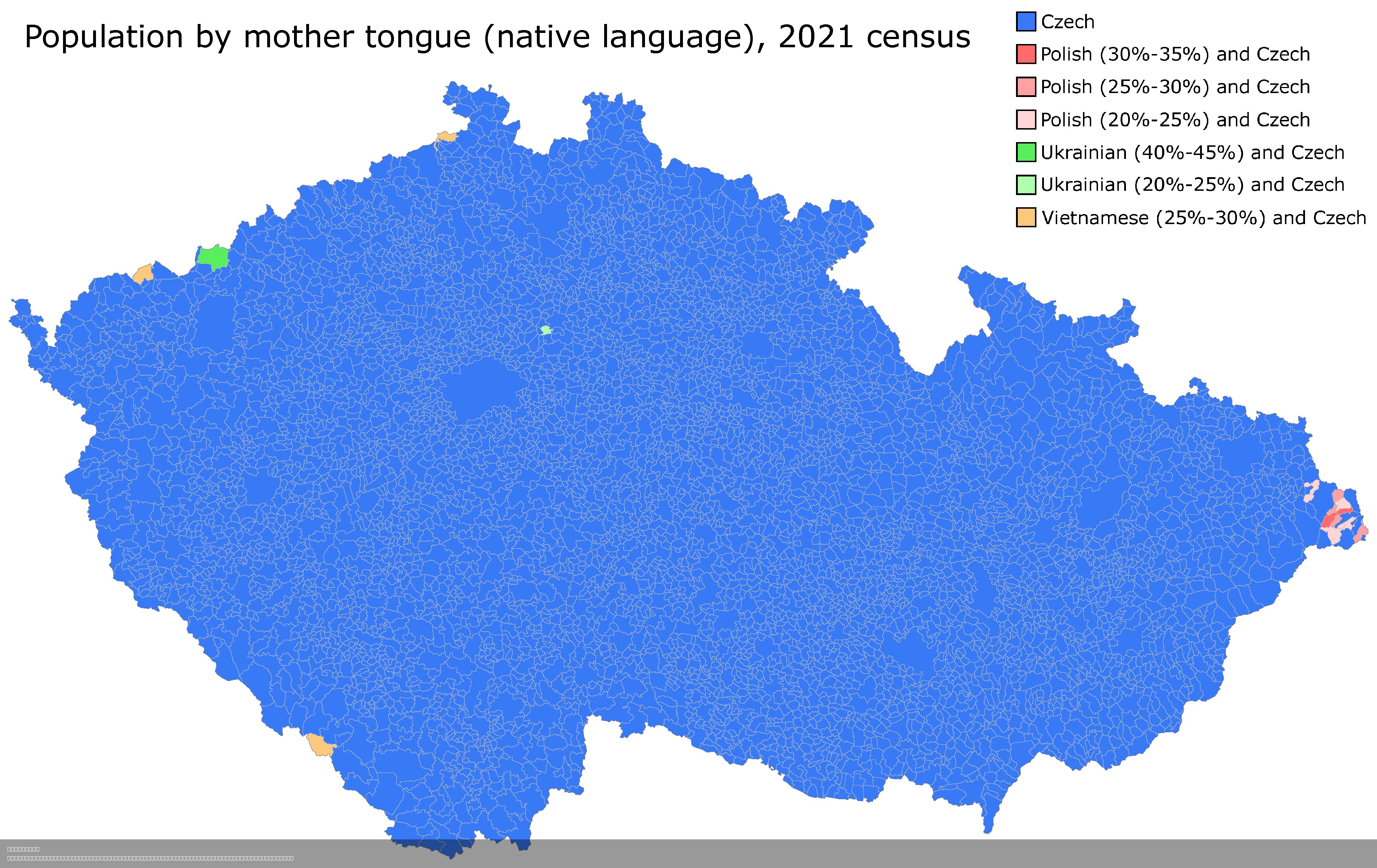Mother Tongue by Municipality in Czech Republic Map


David Chen
Data Visualization Specialist
David Chen is an expert in transforming complex geographic datasets into compelling visual narratives. He combines his background in computer science ...
Geographic Analysis
What This Map Shows
The map titled "Mother tongue (native language) by municipality in the Czech Republic, 2021" provides a detailed visualization of the linguistic landscape across the municipalities of the Czech Republic. It highlights the distribution of various mother tongues, reflecting not only the ethnic diversity but also the cultural richness of the nation. Each municipality is color-coded to represent the predominant language spoken, revealing insights into the demographic structure of the Czech people and their communities.
However, this map goes beyond mere colors and shapes; it serves as a window into the social fabric of the country, illustrating how language plays a crucial role in identity, culture, and even local governance.
Deep Dive into Language Diversity in the Czech Republic
Language is more than just a means of communication; it shapes our identity and influences how we perceive the world around us. In the Czech Republic, Czech is the official language, spoken by approximately 94% of the population. This dominance reflects the country's historical and cultural legacy, as well as its efforts to maintain a cohesive national identity. However, what's fascinating is the presence of various minority languages, particularly in regions with significant ethnic communities.
For instance, in areas like Ústí nad Labem and Karlovy Vary, you will find a notable presence of German-speaking populations, a remnant of the historical coexistence of Czechs and Germans. Similarly, the Moravian-Silesian Region showcases Slovak speakers, stemming from the historical ties and geographical proximity to Slovakia. Other languages, such as Romani and Polish, also contribute to the linguistic mosaic, particularly in regions where these communities are concentrated.
Interestingly, the 2021 census data indicates that while Czech remains dominant, the number of speakers of minority languages has remained relatively stable, suggesting a resilience of cultural identity. This linguistic diversity is not merely a statistic; it influences various aspects of life, from education to social interactions, and even local politics. In some municipalities, bilingual education programs are being implemented to cater to minority language speakers, promoting inclusivity and understanding among different communities.
Regional Analysis
Examining the map reveals significant regional variations in language use across the Czech Republic. For example, in Prague, the capital city, a melting pot of cultures and languages, you might encounter a wide array of languages spoken due to its status as a global city. The cosmopolitan nature of Prague attracts expatriates and foreign students, making it a hub for linguistic diversity beyond the native tongues.
In contrast, rural areas such as Vysočina and Zlin show a more homogenous linguistic profile, predominantly featuring Czech speakers. These regions often reflect a more traditional lifestyle, where the influence of minority languages is less pronounced.
Moreover, the regions of South Moravia and Olomouc display pockets of Slovak and German speakers, reflecting historical migration patterns and regional ties. The presence of these languages can lead to unique cultural festivals and community events that celebrate their heritage, further enriching the local culture.
Comparing the municipalities can reveal intriguing patterns; for instance, areas with higher percentages of minority language speakers often have more vibrant cultural scenes, showcasing traditional music, art, and cuisine from their respective communities.
Significance and Impact
Understanding the distribution of mother tongues in the Czech Republic is crucial for several reasons. Firstly, it highlights the importance of language as a vehicle of culture and identity. In a world that is increasingly globalized, preserving minority languages is essential for maintaining cultural diversity.
Furthermore, the implications of this linguistic landscape extend to education and social policy. Local governments may need to consider language needs in educational curricula, ensuring that minority populations receive adequate support. This is especially pertinent in multicultural areas where multiple languages coexist.
Looking ahead, trends indicate that while the Czech language will likely remain the predominant language, the resilience of minority languages suggests a growing recognition of their importance. Advocacy for bilingual education and cultural programs may increase, fostering an environment where linguistic diversity is celebrated rather than diminished.
In conclusion, the map of mother tongues across the municipalities of the Czech Republic serves as a vital tool for understanding the country’s demographic and cultural dynamics. It paints a rich picture of linguistic diversity, prompting us to appreciate not only the languages themselves but also the histories and communities they represent.
Whether you are a local resident or a visitor, understanding this aspect of the Czech Republic can enhance your experience and connection to the land and its people.
Visualization Details
- Published
- August 4, 2025
- Views
- 132
Comments
Loading comments...